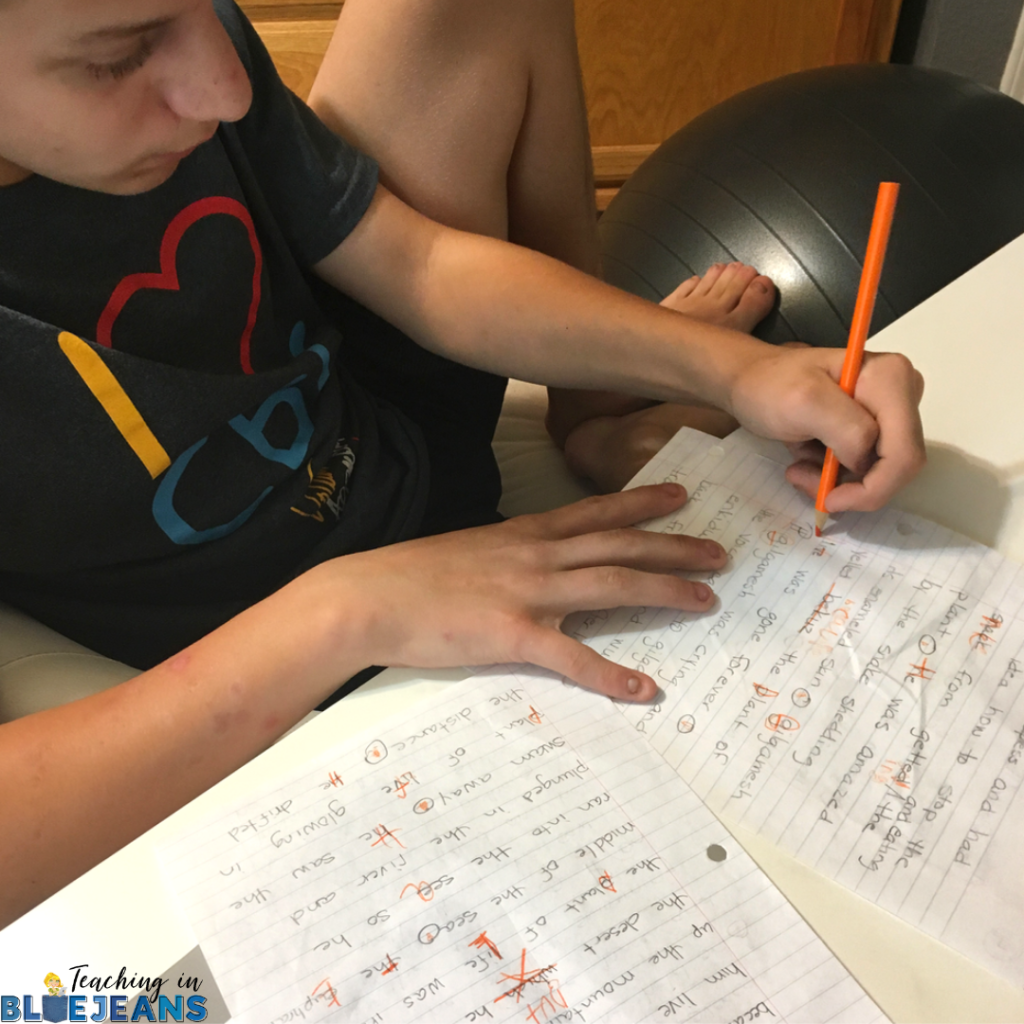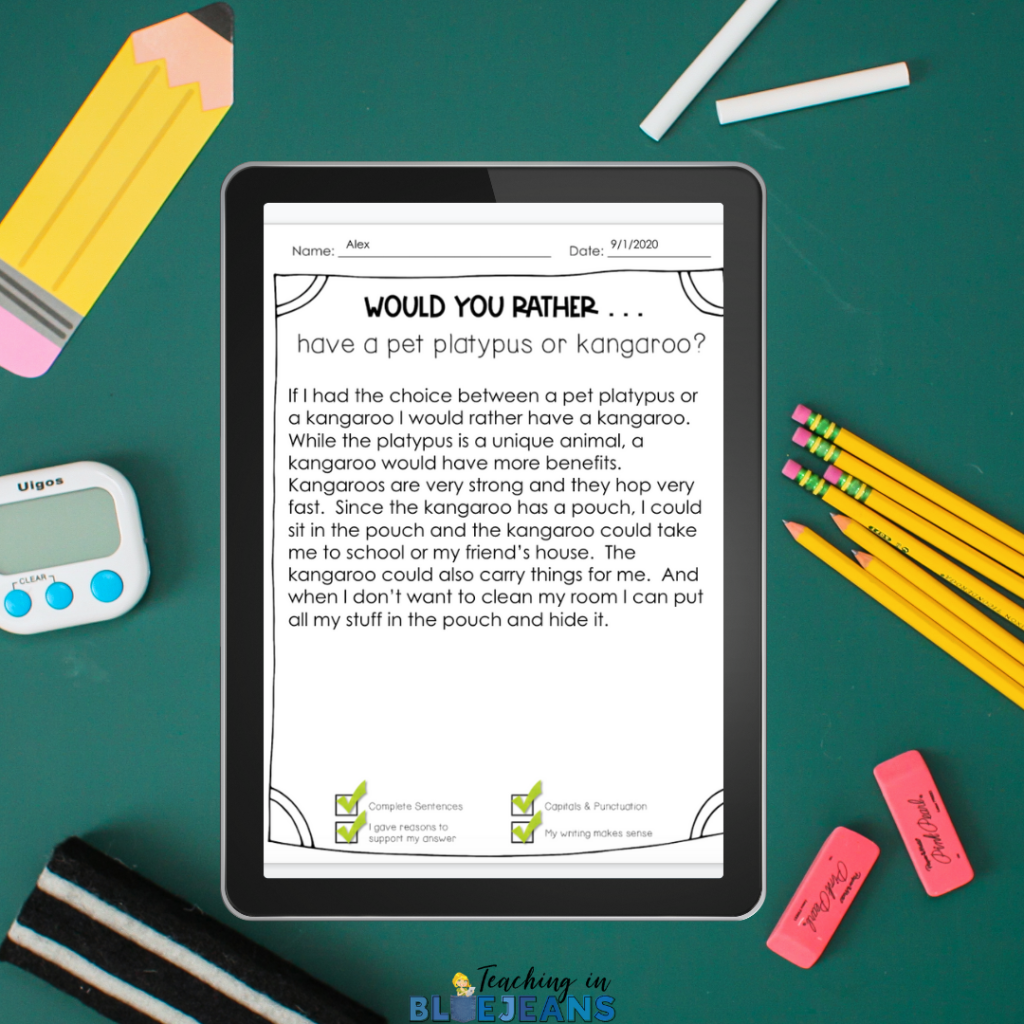What can make someone clean their room, cry, snap pencils and tear paper? Writing. What can make an otherwise outgoing and often loud and fidgety student sit quietly so as to not be noticed? Writing. Hi. I’m Amy and I’m the mom of a reluctant writer. Both at school and at home, my son is a master at avoiding writing. As a teacher mom I set out to find ways to help my son (and other students) stop avoiding and start writing without all the side effects. I’m excited to share some of my favorite ways to engage reluctant writers. P.S. These tips work great for all writers!

1. Provide a Starting Place
There is nothing more intimidating to a reluctant writer than a blank piece of paper. Just the sight of that and the thought of having to fill it with words is enough to make them shut down.
Choose a good writing prompt
Avoid the mental shut down by giving students a starting place. Writing prompts are great for this, but not all writing prompts are created equal when it comes to the reluctant writer.
Choose a writing prompt that limits choice. Open ended or unlimited possibility writing prompts are just too much and can cause the reluctant writer to get overwhelmed with the possibilities. Instead choose prompts that are more limiting. If there is choice in the prompt, limit it to 2 options. If there is a topic to write about, be very specific on what aspect of that topic the student should address. These work great for the entire class, but if you can’t do this with the whole class, then do this through a pre-writing conference with the individual student. By talking through how you would narrow down the prompt, you are actually modeling thinking skills they will be able to use later on their own.
These printable and digital Would You Rather writing prompts have the reluctant writer seal of approval! These seemingly simple prompts can be the basis for some great writing. Kids love the sometimes silly, sometimes serious, sometimes completely off the wall questions.
Try picture writing prompts
Picture writing prompts are a great starting place too! Students use the picture as the starting place for the writing. By starting with what they see, reluctant writers can ease into the writing process. Then they can begin adding their own details and ideas to complete the story.
These picture writing prompts can be really versatile too. While they can easily be used to tell a story, you can also use them with other writing styles too. You can use them to have students work on a variety of different writing styles. By altering your instructions students can work on a variety of writing skills with the same picture.

Here’s an example of how one picture writing prompt can be turned into a variety of writing assignments. Let’s use this penguin picture writing prompt as an example. With this one page you could have your students working on all of these writing skills:
- Write a story about a penguin (creative writing)
- Write about a time you have seen a penguin in person or on TV or in the movies (personal narrative)
- Make a list of 10 facts about a penguin (list writing / expository writing)
- Pretend you were a penguin. Write about a day in your life. (Point of view)
- Write a paragraph about penguins based on what you learned in the science lesson (Expository writing)
- What are the penguins looking at? Add to the picture and then write about what they see. (Writing details)

These are just a few of the ideas that I came up with in only a couple of minutes. Pairing the picture with the narrow writing prompt, you are setting your reluctant writers up for success!
2. Make Writing Fun
We ask our students to write – a lot! And this is not just for writing instruction. They write all day long. And while this is not a big deal for most students, for the reluctant writer it’s torture. By the time we actually get to writing lessons, they are all out of writing juice.
One of the ways we can engage the writer that is already burnt out on writing is by making it fun for them. The fun might come from the writing prompts, but it can also come in the mode. Remember – the goal is for them to learn how to get their thoughts onto paper in an organized and clear way. This doesn’t always have to include pencil and paper.
Do a daily writing journal? Let them write with markers, colored pencils, pens, or whatever they want (as long as its not harmful). Writing a personal narrative? Let them create a comic strip instead of paragraph. Writing a persuasive paper? How about writing a commercial.
And in this 21st century, writing doesn’t have to involve paper at all. Not only does writing with technology make it fun, but it teaches our students technological skills they will use throughout their life.
These Build a Scene Interactive Digital Writing Prompts are a fun way to engage students with writing on the computer. Using a variety of digital stickers, students will actually create their own scene to write about. Check them out in action in this short video.
3. Don’t Start With Writing
For many, if not most, reluctant writers, a break down happens when they start writing. But if you ask these kiddos to tell you the same thing without writing, they have lots to say. This stumbling block often leads students to writing less than they really can. A student who might be able to give a 2 minute oral answer to a writing prompt might opt to write only 2 sentences.
Let students start their writing orally. This can be done using a voice to text app on the computer, tablet or smartphone, a voice recorder , or even by having another person do the writing. This allows the students the opportunity to get their thoughts down on paper. While it sounds like they aren’t writing at all, I can tell you from experience it is really effective.
Once the initial draft is completed using an oral approach, students are then freed up to focus on the writing skills that otherwise get lost in the mental block. Students can work on editing mistakes, improving sentence structure and adding sensory details. They can learn the skills and the processes.

Personal Experience
When we started homeschooling, I started transcribing some activities for my son. How did I choose what to transcribe? Well, I looked at the learning objective. If the goal was to see what he learned about science, he answered orally and I transcribed. If the goal was grammar or editing, I transcribed using only lower case letters and no punctuation. But if the goal was to write a paragraph, he did the writing. I might also make some intentional mistakes to help with the learning objective. This way he had plenty to work on that met the assignment goal.
Once we started doing this there was a lot less procrastination, a lot less groaning, a lot less attitude and a lot less arguing. You see, we overcame the initial hurdle. When he is asked to write now, he does it without arguing.
4. Not All Writing Must Be Finalized
One of the hardest things for reluctant writers is just the process of getting their thoughts on paper. This one process which is often taken for granted in the writing process is really, really hard for reluctant writers. Add to that the demands of correct spelling, good grammar, proper sentence structure, vivid word choice and good handwriting and you have DREAD!

Let your students just practicing getting their thoughts into writing without all the stuff. This in and of itself is a very important writing skill! This can easily be done with a daily quick write or a morning writing journal. Here’s some tips on how to do this in a way that won’t make your reluctant writers dread it:
- Don’t set an expectation on writing length
- Let your kids know from the beginning that they won’t be graded
- Set a time limit of around 10 minutes
- Give them permission not to finish the writing as long as they write for 10 minutes
- Provide a simple prompt or let them continue a writing from a previous day
- Just encourage them to write
When it’s time to take a piece of writing through all the steps, students can start a new piece or pick one from this journal.
5. Break it Down – Guided Writing
When you do have writing assignment that must start with a blank piece of paper, break down the steps. Don’t just leave them staring at a piece of paper. Instead, teach them the skills (through modeling) on how to break down the thinking, planning and writing process. And for the reluctant writer, this will very likely be in more steps or smaller chunks than other students need.

I like to think of the writing process as a puzzle. There are lots of individual pieces that have to go together to create a finished writing.
The Traditional Writing Process
The traditional writing process looks something like this:
- Prewriting
- Rough Draft
- Revise and Edit
- Final Draft
And for most students, this is like handing them a fairly easy 50 piece puzzle. However, when you stop and think about each of these steps, there are actually multiple components thats go into them. For the reluctant writer, this is more like dumping a 1000 piece puzzle on the desk, asking them to complete it without showing them what the finished puzzle should look like.

The Broken Down Writing Process
But we can help. We can help by breaking each step down even further. For a reluctant writer, it might look like:
- Brainstorm Topic
- Write words about the most important things for the topic
- Organize those words into a logical order
- Turn words into a sentence
- Turn the sentences into a paragraph
- Repeat for multiple paragraphs
- Revise in stages, focusing on one revision style at a time (adding details, does it make sense / organization, word choice, etc.)
- Edit in stages, focusing on one editing skill at a time (correct spelling, subject verb agreement, capitals, punctuation, etc.)
- Write final draft using the work already done.

By breaking it down into smaller chunks, we take away all.the.things that lead to overwhelm. Remember, the student struggles are generally with the process, not the know how. They remember all the puzzle pieces you’ve taught them about revising and all the puzzle pieces you’ve taught them about editing. When you say revise and edit they are remembering all the things. But by breaking it down we allow them to focus on all the things one thing at a time.
You’ve Got This!
Engaging reluctant writers can be tough. One of the biggest things I’ve found that helps is getting buy-in from the beginning. For many reluctant writers that means acknowledging that writing is tough, assuring them you are there to help through every step, and explaining how the writing is going to be different from past writing experiences. This last part is really key and could include things: limited writing time, smaller writing chunks, and fun writing methods and topics.
You’ve got this my friend!
And if you feel overwhelmed, stuck or just need ideas to help a specific student, I’m here for you. Just shoot me an e-mail at [email protected] and we can tackle it together.
Save these Tips and Ideas for Engaging Reluctant Writers
Chances are, if you don’t have a reluctant writer now, you will in the future. Save these tips for engaging writers on your favorite classroom Pinterest board so you can come back later.




Leave a Reply